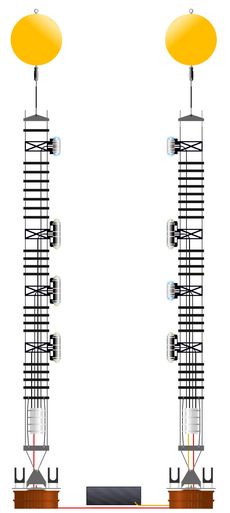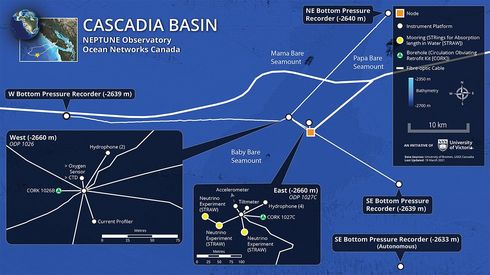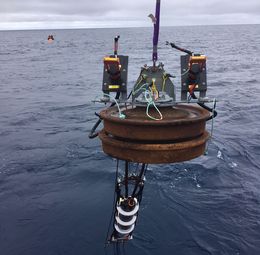STRAW pathfinder shows Cascadia Basin is qualified for P-ONE

After two years of continuous operation, measurements from STRAW show an optical attenuation length of about 28 metres at 450 nm. Additionally, the data allows a study of the ambient undersea background. The overall optical environment was found to be comparable to other deep-water neutrino telescopes and qualifies the site for the deployment of P-ONE.
The design of STRAW
The STtrings for Absorption length in Water (STRAW) experiment is the first in a series of pathfinder missions for the Pacific Ocean Neutrino Experiment (P-ONE), a future large-scale neutrino telescope in the north-eastern Pacific Ocean. The experiment is designed to measure the attenuation length of the water and perform a long-term assessment of the optical background at the future P-ONE site.
The concept of STRAW (see left) follows the principles of neutrino telescopes and consists of two 150 m long vertical mooring lines spaced 37 m apart. Different optical modules are mounted along each mooring line at 30 m, 50 m. 70 m and 110 m above seafloor.
The three POCAMs (Precision Optical Calibration Modules), initially designed to act as light emitting calibration devices for the IceCube neutrino telescope, are used for emitting intense, adjustable, isotropic, nanosecond light flashes that are observed by the surrounding five sDOM units (STRAW Digital Optical Modules). All modules are housed in titanium cylinders with glass hemispheres at both ends, one hemisphere facing upwards and the other facing downwards.
The assembly of STRAW took place at the TUM laboratories in Garching from January to March 2018. On 25 June 2018, the two STRAW mooring lines were anchored by ONC on the seafloor of the Cascin in the Pacific Ocean at a depth of 2600 m. After a commissioning and test phase, continuous operation began in March 2019. The sensors are collecting data since then. (Picture: TUM)
The location of STRAW
The two STRAW mooring lines are deployed within the ONC NEPTUNE observatory and connected to the node in the Cascadia Basin at 47º 46' N, 127º 46' W, at a depth of 2660 m. The map also shows the location of STRAW-b, the successor mission to STRAW which is currently taking data to complement the measurements of STRAW.



